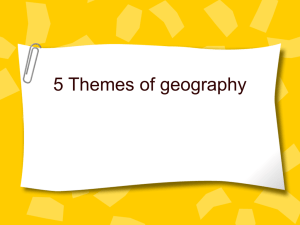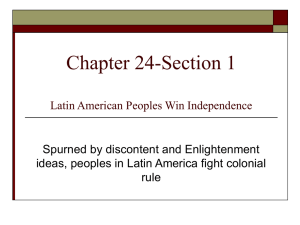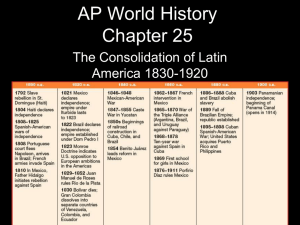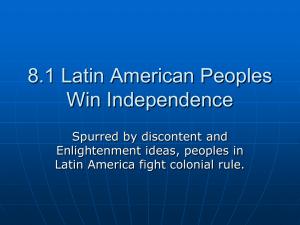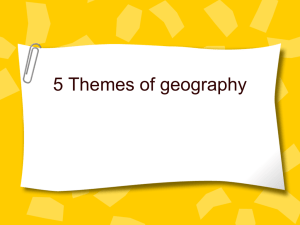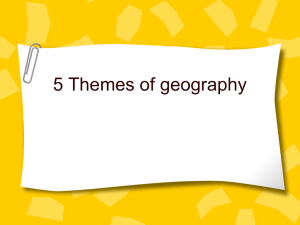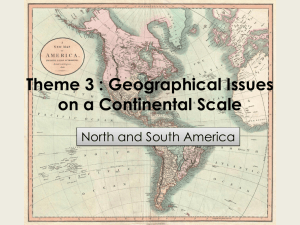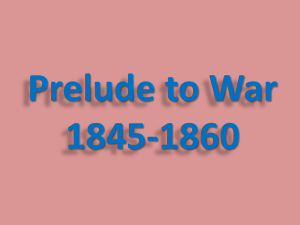Nation Building and Economic Transformation in the Americas, 1800
advertisement
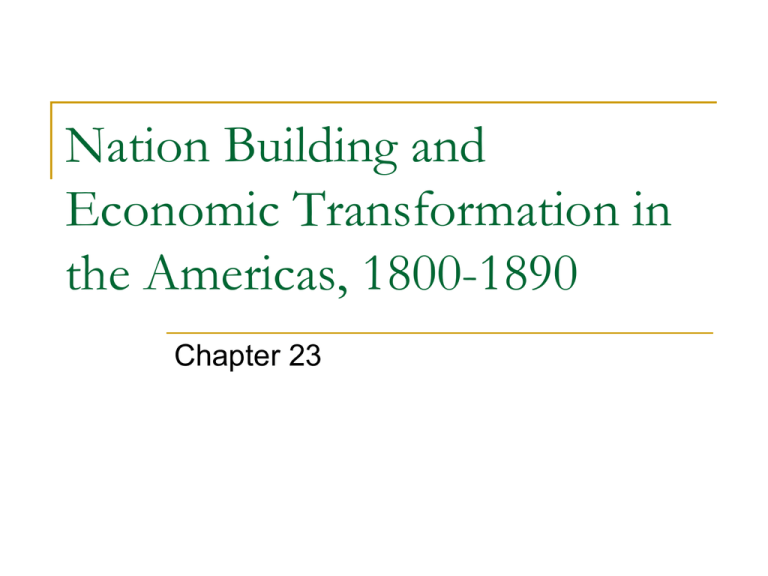
Nation Building and Economic Transformation in the Americas, 1800-1890 Chapter 23 Independence in Latin America 1800-1830 Roots of Revolution, to 1810 U.S. Declaration of Independence and Fr. Declaration of the Rights of Man were circulating in Latin America Elites upset at the power held by colonial officials upset about high taxes trouble in Europe led to ideas of revolution Napoleon invading the Iberian peninsula 1808, the Portuguese royal family went to Brazil King John VI ruled from there for 10+ years Napoleon replaced the Sp. monarch with his brother Joseph Bonaparte Sp. patriots formed the Junta Central to govern Spain while the King remained a Fr. prisoner The Junta claimed control of all of Spain’s territories Many wealthy Sp. colonists did not like the Junta 1808 and 1809- uprisings overthrew the Sp. officials in Venezuela, Mexico, and Alto Peru Sp. officials quickly regained control and punished the leaders This made more people support the revolutionists Spanish South America, 1810-1825 Caracas (capital of Venezuela) revolutionary Junta led by Creoles declared independence in 1811 leaders were large landowners supported slavery opposed citizenship for black and mixed-race people colonial administration reacts rally free blacks and slaves to defend Spain Revolutionary officials turned to Simon Bolivar son of wealthy planters had studied classics and the Enlightenment agreed to support emancipation to get slaves to help and to get supplies from Haiti he gets the help of English soldiers Spain, 1820 Ferdinand VII is returned to the throne forced to sign a constitution that limits his powers Bolivar’s Army liberates Venezuela, Columbia, Ecuador, Peru and Bolivia (named for Bolivar) Buenos Aires important center of revolution a Junta formed that claimed loyalty to Ferdinand VII while he was imprisoned they declared independence after Ferdinand returned to the throne United provinces of the Rio de la Plata They were unable to control the region and chaos broke out San Martin, a military leader was able to cross the Andes and attack Sp. troops in Chile and Peru Won in Chile, lost in Peru Unable to win in Peru, he gave command of his troops to Bolivar who defeated the Spanish in 1824 Mexico, 1810-1823 Spain’s wealthiest and most powerful colony in 1810 rich silver mines Mexico City was larger than any city in Spain largest population of Spanish immigrants Spanish loyalists overthrew the viceroy when Ferdinand was forced to abdicate the throne Rebellion central Mexico wealthy farmers had forced Amerindians from their land crop failures and epidemics made the situation worse Miguel Hidalgo y Costilla parish priest urged people to rise up against Spanish oppression rural poor joined him, they had no military experience or weapons randomly attacked their oppressors, the ranches and mines Hidalgo was captured, tried, and executed in 1811. Jose Maria Morelos a priest better military and political leader than Hidalgo set up a congress that met and created a constitution in 1813 he was defeated and executed in 1815 colonial rule seemed secure in 1820 Mexican loyalists, led by Colonel Agustin de Iturbide, later declared independence from Spain and Mexico declared Iturbide the emperor. 1823, Mexico became a republic Brazil, to 1831 1808, Portuguese royal family moved to Brazil stimulated economy gave more power to colonial elite 1821, King John VI returned to Portugal, left his son Pedro in Brazil People surrounded by revolutions for independence questioned their own colonial status Pedro I declared independence from Portugal and Brazil had a constitutional monarchy different political opinions and high costs of running the new government forced Pedro to abdicate in 1831 Pedro II ruled until 1889 The Problem of Order 1825-1890 Constitutional Experiments Just like in the U.S., Latin Americans felt a constitution was necessary careful description of political powers protected the people constitutions were often ratified and then rejected societies were not accustomed to voting British colonies had voted for elected officials in town governments Spanish and Portuguese America had little or no experience voting for representatives Nearly all limited the right to vote to free men owning property British colonies in Canada want democracy and effective self rule 1837 – armed rebellion 1840s – Britain allows limited self rule Confederation of 1867 Ontario, Quebec, New Brunswick, Nova Scotia Beginning of the Canadian nation Latin America drafters of the constitutions had no experience with elected governments hard to define the political role of the Catholic Church many early constitutions had tried to reduce its power secular education permitted other religions tried to limit the power of the military strengthened during the wars of independence military leaders would not follow civilian authorities Brazil, led by Pedro I was the exception Personalist Leaders Successful leaders gained popularity in the U.S. and Latin America used patriotic symbols used personal followings to gain national political leadership ex. Iturbide in Mexico; Bolivar in Gran Columbia caudillo – a personalist leader who held political power without constitutional sanction early constitutions excluded the poor from political participation Personalist leaders often became dictators Andrew Jackson and Jose Antonio Paez both challenged constitutional limits Paez – led Bolivar’s cavalry in Venezuela and Columbia uneducated and poor, his personality and strength made him popular Bolivar tried to unite Latin America under his rule Paez declared Venezuela independent Ruled as president or dictator for the next 18 years Jackson – a self made man was popular among frontier residents, urban workers and small farmers he served as judge, general, congressman, senator and President military success beat the British – Battle of New Orleans in 1815 took Florida from the Sp, in 1818 1828 – elected as President by a landslide 1832 – reelected Was able to take power from Congress personalist leaders in Latin America didn’t face many obstacles and were able to gain more power than those in the U.S. The Threat of Regionalism New governments were weaker than old colonial governments elites led uprisings or disobeyed laws that threatened their interests all attempts to form large multi-state federations failed Republic of Central America Split into 5 separate countries Gran Columbia Venezuela, Columbia and Ecuador split into separate countries Bolivia, Uraguay, Paraguay and Argentina Had been under one viceroyalty, but split after independence in 1830 Argentina Sought strong central government Secular education, free trade and immigration Conservatives supported Catholic Church education and protection of local products from European imports rebelled a constitution that went against these values Juan Manuel de Rosas, a caudillo, came to power and ruled for 20+ years economy expanded use of mob violence and assassination made him many enemies overthrown in 1852 United States Regional problems ex. Senate in which each state is equally represented due to small state fears slavery polarized the country Louisiana Purchase; 1803 War with Mexico to gain Texas New land gains led to a debate over whether slavery should be allowed to spread immigration led to higher population and more political power in the north 1860; Abraham Lincoln was elected President Southern states seceded, formed the Confederate States U.S. Civil War (1861-1865) Union victory led to the abolition of slavery in the U.S. Foreign Interventions and Regional Wars 19th century – countries that had gained their independence continued to fight War of 1812 U.S. vs. Great Britain 1898-1899 Mexican-American War U.S. vs. Spain Gained the Philippines and Puerto Rico British and French Naval blockades of Argentina Mexico had to defend itself from Spain in 1829 and the French in 1838 in 1836, Texas gained its independence from Mexico 1848, Mexico was forced to give land to the U.S. (now New Mexico, Arizona and California) for $15 mill. 1862, France invaded Mexico Benito Juarez, forced to flee Mexico French installed the Austrian Hapsburg Maximilian as emperor Mexican forces drove the Fr out in 1867 Chile defeated the Confederation of Peru and Bolivia on several occasions Argentina and Brazil fought over Uruguay until Uruguay’s independence 1865; Argentina, Uruguay and Brazil joined to fight Paraguay Native Peoples and the Nation-State In many cases, colonial powers had tried to protect native people New independent governments were too weak to protect their frontiers United States settlers looking for agricultural land pushed into native territory Tecumseh and his brother formed an Amerindian Alliance in the Ohio River Valley Tecumseh was killed in the War of 1812 1830 Indian Removal Act Passed by Congress Forced native tribes to settle west of the Mississippi River Trail of Tears, nearly half of the forced migrants died Great Plains Amerindians were more of a challenge Had mastered the use of horses and firearms Became nomadic buffalo hunters during the U.S. Civil War disrupted Amerindian trade buffalo herds were hunted to near extinction forced to give up their land and traditions Argentina and Chile the native people were successful and militarily strong they had the upper hand until the 1860s 1870s; Argentina & Chile used overwhelming military force Crushed native resistance Mexico plantation owners pushed Mayans off of their land Mayan rebellion 1847, Caste War created their own state until 1870 when they were defeated by Mexican forces The Challenge of Social and Economic Change The Abolition of Slavery Anti-slavery movements during the independence movements in the North and the South revolutionary leaders wanted freedom and citizenship United States slave trade stopped in 1808, slavery continued cotton agriculture was still profitable abolitionists said slavery went against the rights mentioned in the Declaration of Independence as well as most religions Women and free African Americans tried to end slavery Were not granted full citizenship themselves Produced effective propaganda Frederick Douglas A former slave Abolitionists speaker and writer U.S. Civil War thousands of black freemen and escaped slaves fought for the Union 1863 – Lincoln issues the Emancipation Proclamation 1865 – end of the civil war, Thirteenth Amendment abolished slavery 1880s – increased segregation and racial violence Spanish America slaves gained freedom by joining revolutionary armies Brazil and Cuba increased their slave trade because of profits Brazil 1830 – treaty with the British to end the slave trade Continued to illegally import slaves Pedro II and many liberals worked to abolish slavery many slaves joined the army to fight Paraguay 1888 – legislation abolished slavery Caribbean Islands received 40% of all incoming slaves most people were not interested in independence slave revolts were inspired by the Haitian revolts on Saint Domingue abolition resulted from European colonial powers Slavery lasted longest in Cuba and Puerto Rico 1873 – abolition in Puerto Rico 1886 – abolition in Cuba End of the slave trade Great Britain ended the slave trade in 1807 asked that Spain, Brazil and others stop trading slaves as well 1833 - Slavery in British colonies ended “freed” slaves were required to stay with their masters as “apprentices” Immigration 19th century wave of immigrants from Europe and Asia rapid economic growth occupation of frontier regions urbanization before 1870 most came from Western Europe after 1870 most came from southern and eastern Europe U.S. national population increased 1871 – 39 million 1891 – 63 million (62% increase) Immigration to Latin America and Canada also increased (especially Argentina) Large numbers of Chinese and Indian immigrants were arriving as well Hostility to immigration nativist political movements fear and prejudice some immigrants seen as undesirable (Asians) were more often victims of violence and discrimination 1870s and 1880s –anti-Chinese riots Chinese Exclusion Act of 1882 in the U.S. Southern Europeans were also discriminated against Jews from Eastern Europe Italians were seen as violent Barred from education and careers Feeling that immigrants accepted low paying jobs and threatened the national culture Assimilation movements attempt to create a national language and a national culture through education American Cultures Immigration altered culture and politics creation of ethnic clubs and neighborhoods acculturation – modification of culture of a group due to contact with people from another culture Women’s Rights and the Struggle for Social Justice Political and economic discrimination towards blacks, women, new immigrants and native peoples United States The Women’s Rights Convention “We hold these truths to be self-evident that all men and women are created equal.” women began to demand the right to vote tried to improve working conditions for women Canada Progress equally slow Argentina and Uruguay 1895 – first time a woman could receive a medical degree in Canada Women led the way in temperance, child welfare and labor reform First L. American nations to provide education for women Improvements were seen faster in low level careers that did not financially threaten men Racial discrimination blacks were denied the vote in the Southern U.S. segregation segregation was not as evident in Latin America, but there was discrimination Development and Underdevelopment Western Hemisphere was richer in 1900 than in 1800 industrial revolution, population growth, and an integrated world market Exports: wheat, corn, wool, meats, non-precious minerals, silver, sugar, dyes, coffee and cotton Governments invested in roads, railroads, canals and telegraphs mining booms in Western U.S., Mexico and Chile new technology meant dependence on foreign money two economy types development – improved and modernized underdevelopment – stuck in the colonial system of selling raw materials and low wage industries Altered Environments Western Hemisphere introduction of new technologies, plants and animals deforestation in Cuba the spread of ranching in Argentina, Uruguay and Brazil use of the steel plow caused soil erosion in the plains of N. America and Argentina slash and burn agriculture in Brazil Urbanization the difficulties of providing clean water, removing garbage and sewage railroads led to deforestation conservation efforts began
